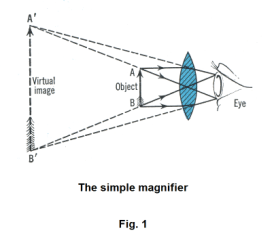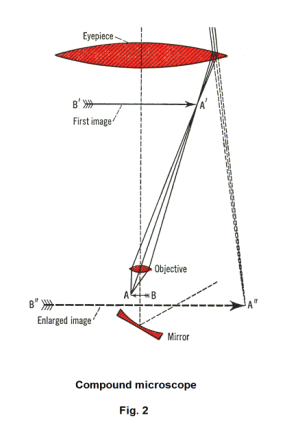
Website owner: James Miller
Optical instruments. Simple magnifier. Compound microscope. Refracting telescope. Reflecting telescope. Projector.

The simple magnifier. The simple magnifier employs a double convex lens of short focal length. The lens is held a little closer to the object than one focal length and the eye is placed close to the lens on the other side. The image is enlarged, vertical and erect. See Fig. 1.
The magnification is given by
![]()
where the 25 cm represents the least distance from eye to lens for distinct vision.

The compound microscope. A compound microscope, usually simply called a microscope, utilizes two converging lenses, one at each end of a brass tube whose length is adjustable. The lens near the object is called the objective and the lens near the eye is called the eyepiece or ocular. The microscope forms an enlarged real image by means of the objective and this image is then magnified by the eyepiece. The objective lens has a very short focal length fo. The object AB is placed just outside the principal focus of this lens (a little further from the objective than its focal length fo). See Fig. 2. An enlarged real, inverted image A'B' is formed at a distance a little over 2fo from the objective, and just within the principal focus of the eyepiece. The eyepiece acts as a simple magnifier to magnify this image, giving the final image A''B''. A mirror at the bottom reflects light on the object.
The magnification is given by

where L is the distance between the objective and the eyepiece (i.e. the length of the adjusted tube), fe is the focal length of the eyepiece, and all measurements are in centimeters.
The refracting telescope. The refracting telescope consists of a long, heavy tube of adjustable length with an objective lens at one end and an eyepiece at the other. The optical system is essentially the same as that of a compound microscope. In both cases an image is formed by the objective lens and this image is then magnified by the eyepiece. The difference is that the telescope is designed to examine large objects at large distances and the microscope is designed to examine small objects close at hand. The objective of a telescope is a large convex lens, capable of admitting large quantities of light, that may be as much as 40 inches in diameter. The image formed by the objective is real, inverted, reduced and very bright. Because the objects viewed are at such large distances, the image that is formed is located just beyond and very close to the objective’s second focal point. In addition, the telescope is adjusted so that the objective’s image is at the focal point of the eyepiece. Thus if fo is the focal length of the objective, fe is the focal length of the eyepiece, and L is the distance between the objective and the eyepiece (i.e. the length of the adjusted tube), then L = fo + fe. The image seen in the eyepiece is an inverted image. In terrestrial telescopes where it is necessary to see the image right side up, additional lenses are placed between the objective and the eyepiece to invert the image.

The magnification is given by

The reflecting telescope. The largest telescopes in the world are reflecting telescopes. The reflecting telescope uses a large concave mirror instead of an objective lens. Because it is easier to make a large mirror than it is to make a lens of the same size, a reflecting telescope can be made much larger than a refracting telescope. The reflecting telescope consists of a heavy tube,

open at one end, and with a large parabolic mirror at the other end. The eyepiece is located at the side of the tube at a 90o angle to the tube. A small reflecting prism or mirror diverts the light rays into the eyepiece as shown in Fig. 4.
The image produced by the mirror is real, inverted, and located near the principal focus of the mirror. This image is reflected out of the path of the rays of light incident on the mirror and is magnified by the eyepiece.
The projector. Fig. 5 shows a diagram of a slide projector. The slide is located just slightly over one focal length from the objective lens. The screen is located considerably more than twice the focal length of the objective. The image is real, inverted and enlarged. Because it is inverted, the slide must be put into the projector upside down. The purpose of the condensing lenses is to focus the light so that it will pass through the slide and objective lens.

References
Dull, Metcalfe, Brooks. Modern Physics
Sears, Zemansky. University Physics
Semat, Katz. Physics
Jesus Christ and His Teachings
Way of enlightenment, wisdom, and understanding
America, a corrupt, depraved, shameless country
On integrity and the lack of it
The test of a person's Christianity is what he is
Ninety five percent of the problems that most people have come from personal foolishness
Liberalism, socialism and the modern welfare state
The desire to harm, a motivation for conduct
On Self-sufficient Country Living, Homesteading
Topically Arranged Proverbs, Precepts, Quotations. Common Sayings. Poor Richard's Almanac.
Theory on the Formation of Character
People are like radio tuners --- they pick out and listen to one wavelength and ignore the rest
Cause of Character Traits --- According to Aristotle
We are what we eat --- living under the discipline of a diet
Avoiding problems and trouble in life
Role of habit in formation of character
Personal attributes of the true Christian
What determines a person's character?
Love of God and love of virtue are closely united
Intellectual disparities among people and the power in good habits
Tools of Satan. Tactics and Tricks used by the Devil.
The Natural Way -- The Unnatural Way
Wisdom, Reason and Virtue are closely related
Knowledge is one thing, wisdom is another
My views on Christianity in America
The most important thing in life is understanding
We are all examples --- for good or for bad
Television --- spiritual poison
The Prime Mover that decides "What We Are"
Where do our outlooks, attitudes and values come from?
Sin is serious business. The punishment for it is real. Hell is real.
Self-imposed discipline and regimentation
Achieving happiness in life --- a matter of the right strategies
Self-control, self-restraint, self-discipline basic to so much in life